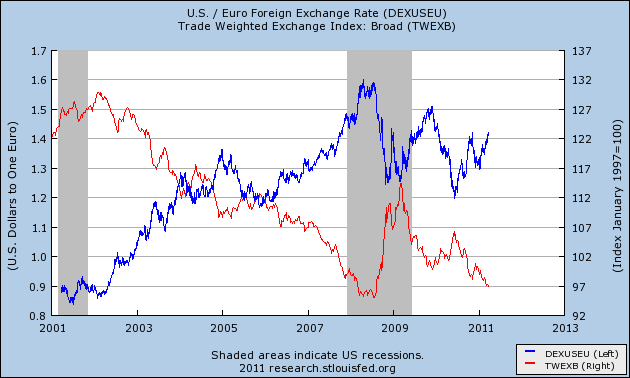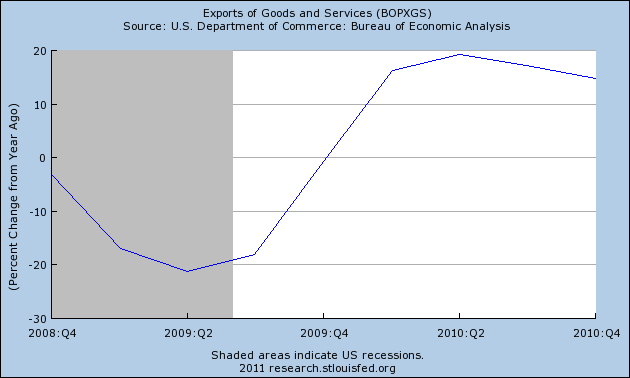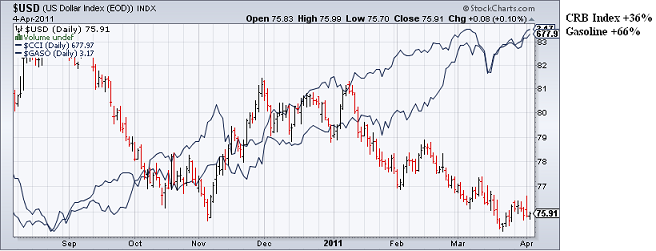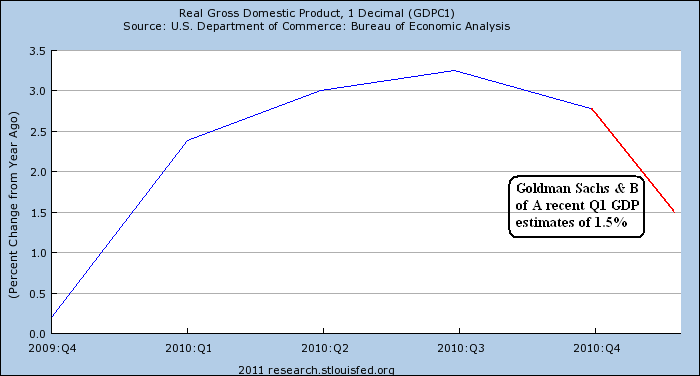It’s a bit early to begin grading the effectiveness of QE2, but we’re nearing the end of the program so we’re beginning to see some definitive conclusions. One conclusion that Paul Krugman makes is with regards to the US Dollar and its effect on the recovery. He says:
“For what it’s worth, casual observation suggests that a lot of the growth in consumer spending has been at the high end, which suggests in turn that a higher stock market might be driving it. And the lower dollar has clearly helped US exporters and import-competing firms.
If QE really is working through stocks and the dollar, are there further implications? I’m not sure — in a highly indebted society, you might hesitate at policies that would increase private debt further, but if stocks are driving the story, the consumers now spending more aren’t the same people who are in debt trouble — so that’s actually OK. And as for the weaker dollar, if the Chinese and the Brazilians don’t like it, they are free to let their currencies appreciate.
Anyway, that’s my casual take on what has happened. I would say that if it’s right, it’s far from clear that the recovery will prove self-sustaining.”
I’ll leave the equity markets for another day, however, there’s two problems with the USD conclusions. Firstly, the trade weighted dollar has become nothing more than an inversion of the Euro based on relative economic expectations and interest rate expectations. This is clear when viewing the near perfect inverse relationship between the two:

With QE on the table in the USA (read, the Fed is remaining at 0% rates) and Trichet and the ECB beginning to get nervous about inflation (and warning that rate hikes could come as soon as next month) it’s not surprising to see the dollar decline and the Euro rising in recent months. This has caused the USD to decline. Okay, so QE is likely impacting the USD to some degree (although hawkish ECB expectations likely have more to do with it).
But secondly, and more importantly, is this dollar decline having any real impact on the US recovery? According to the latest trade data we are indeed seeing an increase in exports, but it’s nothing that wasn’t occurring before QE2 was initiated. In fact, the recovery in exports came well before QE2 started. In addition, the year over year pace has actually deteriorated since QE2 began:

You could build a case that the weak USD is supporting exports (ie, they would be lower without QE), however, the bulk of this recovery in exports came during a period when the Euro was collapsing and the USD was actually rallying (see above chart in early 2010). So it’s almost impossible to definitively say that QE is working through the USD channel to help the economy (it’s certainly not hurting as it is in many other ways). More likely, export growth recovered along with growing global aggregate demand as the global economy recovered in 2009 and 2010. QE1 played an instrumental role in stabilizing the global economy as it alleviated fears and brought some calm to the banking system, however, the evidence showing any direct relationship between QE2, the declining USD and economic strength is flimsy at best.
And none of this even considers the role the declining dollar is playing in other markets such as commodities where the Fed is claiming no blame. This, of course, is a classic case of having one’s cake and eating it too. Pundits like Krugman will be quick to claim the declining dollar is helping exports, but neglect the negative impact of surging commodity prices (most of which are priced in dollars). On the bright side though, we can now confirm (thanks to the SF Fed) that QE2 is putting downward pressure on commodity prices (yes, they really are making this claim). Back on planet earth, however, the impact of higher input prices is having a real impact. As you can see the USD decline has coincided with a 36% surge in the CRB Index and 66% increase in gasoline prices. If Deutsche Bank’s analysis is accurate then the gas price increase alone has nearly wiped out the entire positive impact of the recent tax cut:

And this is all flowing right through to the bottom line in REAL GDP. Contrary to the opinions of the SF Fed, commodity prices really are rising in tandem with QE2 and having a material impact on inflation, consumer spending and real growth:

The latest revisions to GDP show that the pace of the economic expansion is slowing (actually peaked right at the initiation of QE2!) and the downgrades for Q1 2011 are rolling in by the truckload now. Goldman Sachs & Bank of America are both expecting just 1.5% growth….QE2 success? If 1.5% real GDP is success then yes, break out the party hats. Unfortunately, the evidence regarding the USD, QE2 and its success is mixed at best and likely skewed more towards the negative than the positive….
Mr. Roche is the Founder and Chief Investment Officer of Discipline Funds.Discipline Funds is a low fee financial advisory firm with a focus on helping people be more disciplined with their finances.
He is also the author of Pragmatic Capitalism: What Every Investor Needs to Understand About Money and Finance, Understanding the Modern Monetary System and Understanding Modern Portfolio Construction.

Comments are closed.